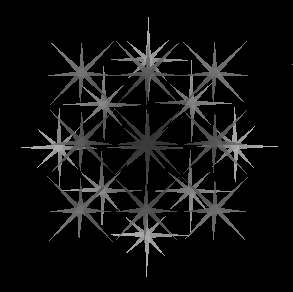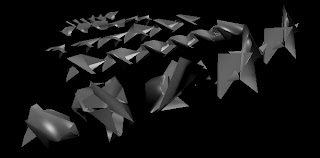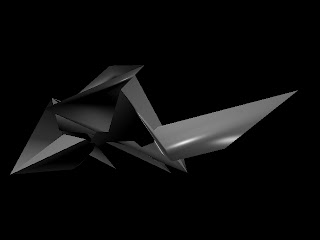Tuesday, May 15, 2012
Project 3 Animation
Here is an animation from Maya of the guitar oscillation movement that inspired my Generative Components surface. It has been batch rendering since yesterday morning, which is why it was not ready at last night's review.
Monday, May 14, 2012
Project 3 Final Stuff
Here are a few more additional occlusion renderings and wireframe images of my surface in various states, using Generative Components.
Final Board for Project 3
Final Board for Project 3
I have an animation as well, but it is currently batch rendering in Maya and will not be ready for the review this evening at 7. It should be ready tomorrow afternoon at some point, so I will post it to the blog then.
Friday, May 11, 2012
Project 3 Progress
I changed around my concept a bit, rather than having an actual guitar string I'm developing more of a surface inspired by the oscillation of a guitar string. I created 4 points, and extruded 2 of the points along different cosine curves. I then attached lines from the points on the two curves that are based on the distances between point 1 and point 2, and point 3 and point 4 accordingly. I then attached a BSpline Surface to the endpoints of these lines, creating my wavy surface form. As I move the control points, the surface begins to warp and grow or shrink based on the distance of the points from the cosine curves.
Here are a few quick rendered images of the surface. Not sure why those splits are occuring in the surface but it looks kind of cool.
Here are some wireframe images of the model so you can begin to see what's actually going on.
Tuesday, May 8, 2012
After enough frustration with GC, I opened Maya to start messing around with the ideas and create some forms. Here are two early images.
The top image is taken inside the "guitar string." The bottom shows the form of the string in it's oscillation over time, similar in movement to the juxtaposition of the two men and the old women in the movie scene that inspired my earlier animation. Anyone know how to create a more nylon string texture in Maya?
Monday, May 7, 2012
Project 3 and GC
With 6 days left before the review, I'm certainly struggling a bit trying to learn this GC software. I've been watching the tutorials on the Bentley Generative Components Youtube page but just not quite getting the hang of it. My idea is take a guitar string from my original object and move it along the path of my motion that inspired my surface objects in part 2. I think this will create an effect almost like a guitar string oscillating over time, maybe through the course of a song. I want to do rendered views and an animation inside this "string" to capture what the experience might be like. Really need to keep working with this software to figure out how I'm going to do so.
Wednesday, April 18, 2012
Project 2 Object
Here are some images of my Project 2 Physical Object. I spent a lot of time conceptualizing how I was actually going to make the very complex surface that I got in Maya into an actual object. 3D printing may have been the best bet to accurately model the complex, curving forms of the rings in the digital model, but I do not yet know how to use it. I think I was successful in modeling the more static rings, or the "jukebox" as we referred to it. However, I think the way in which I modeling the more dynamic rings is not as successful. That was certainly the biggest struggle in transforming this digital model into a physical reality.
Monday, April 9, 2012
Tuesday, April 3, 2012
Saturday, March 31, 2012
First Surface Iterations
Here are two occlusion images of the first iteration of my surface. The idea is derived from the objects the camera focuses on in the first 20 seconds of my Requiem For a Dream Scene. When the camera focuses on the seated women they are stationary and not moving. When focused on Leto and Wayans, the movement is more dynamic because they are in constant movement along with the camera. This inspired the two shapes of the surfaces, and the transitions between the two represent the camera's shifts on each movement. I want to make this all one NURBs object rather than a collection of NURBs cubes and surfaces so that I can begin to deform the entire surface to create a more three dimensional space. Right now as just a wall I feel it is pretty dull.
Tuesday, March 27, 2012
Animation Progress
Monday, March 12, 2012
Project 2 Progress
Saturday, March 3, 2012
Movie
Am thinking about using this opening scene from Requiem for a Dream for my project. It is similar, in a sense, to Malena, in that Jared Leto and Sean Wayan's characters proceed along a line throughout the scene. The camera frequently shifts, which leads the viewer to believe the characters have at some point changed directions, yet we never actually see them depart from the line.
Monday, February 20, 2012
SHoP Architects Reading
Notes while reading:
-"everything that's worth understanding about a complex system can be understood in terms of how it processes information"
-Versioning: Recent shift in way architects are using technology to expand the potential effects on design
-computer has enabled a rethinking of the design process in terms of procedure and outcome, in ways common practice cannot conceive of
-Vector>Pixel
-By not relying on a formal approach, the practice of versioning is capable of responding in a nonlinear manner to various influences
-Methods of disassembly and reuse can be built into the design process through versioning
General Thoughts:
I found this read a little repetitive to the reading last week but I certainly appreciate the overall theme in that technology is changing the process of design and creating new opportunities for designers to experiment with forms that we never may have been able to even think of before. What I found particularly interesting was the discussion of highway design. The different "pieces" to a highway reminded me in a sense of the ideal kit of parts that we think of in architectural design. What amazed me was that highway designers take into account turn radiuses, etc to create an optimal flow of traffic. I had never heard or thought of this before and is certainly interesting to parallel with the architectural design process. We too can manipulate form and space to create optimal means of circulation, vistas, etc in design. In relation to the new technologies, we can design new, nonlinear forms that may do a better job of this now than traditional forms have in the past.
-"everything that's worth understanding about a complex system can be understood in terms of how it processes information"
-Versioning: Recent shift in way architects are using technology to expand the potential effects on design
-computer has enabled a rethinking of the design process in terms of procedure and outcome, in ways common practice cannot conceive of
-Vector>Pixel
-By not relying on a formal approach, the practice of versioning is capable of responding in a nonlinear manner to various influences
-Methods of disassembly and reuse can be built into the design process through versioning
General Thoughts:
I found this read a little repetitive to the reading last week but I certainly appreciate the overall theme in that technology is changing the process of design and creating new opportunities for designers to experiment with forms that we never may have been able to even think of before. What I found particularly interesting was the discussion of highway design. The different "pieces" to a highway reminded me in a sense of the ideal kit of parts that we think of in architectural design. What amazed me was that highway designers take into account turn radiuses, etc to create an optimal flow of traffic. I had never heard or thought of this before and is certainly interesting to parallel with the architectural design process. We too can manipulate form and space to create optimal means of circulation, vistas, etc in design. In relation to the new technologies, we can design new, nonlinear forms that may do a better job of this now than traditional forms have in the past.
1C Pattern Surfaces
I began this part of the project by extracting one of the triangular faces on the top part of the body of my guitar model, because I found it would be one of the more interesting geometries to mess around with. I began with a series of sketches of star-like patterns created by duplicating and manipulating this form to create a two-dimensional star like surface. I then duplicated that surface 9 times to form a 9-starred grid.
After doing so, I combined each individual surface to form one polygonal surface, then duplicated this form and moved it negatively in the Z direction to give it some spatial depth from its predecessor. I then rotated this new 9 starred grid 45 degrees, which in plan view, creates a very interesting, somewhat abstract snowflake like pattern.
Here is an additional three dimensional view looking down on the two two-dimensional surfaces.
After doing so, I combined each individual surface to form one polygonal surface, then duplicated this form and moved it negatively in the Z direction to give it some spatial depth from its predecessor. I then rotated this new 9 starred grid 45 degrees, which in plan view, creates a very interesting, somewhat abstract snowflake like pattern.
Here is an additional three dimensional view looking down on the two two-dimensional surfaces.
Sunday, February 12, 2012
The first row of my Matrix begins with the neck form of the guitar from the previous project and transforms it through a series of edge manipulations.
The second row takes the final form of the previous row and transforms it through a series of face manipulations.
The third row again takes the final form of the previous row and puts it through a series of vertex manipulations.
"Roller-Coaster Construction"
This was an interesting read for me in that it has, in a sense, disagreed or counteracted with certain design principles that I have paid much attention to in past studios. The article encourages removing oneself from the restrictions that materiality and construction can have on creativity during the design process. To not focus on materiality and construction while designing creates new options and allows for a vast array of abstract forms to be thought up and considered. Once the form is derived, building construction and materials can be analyzed. In previous projects, for myself, this has limited me creatively during the design process, and is certainly something to think about moving forward with future projects.
This was an interesting read for me in that it has, in a sense, disagreed or counteracted with certain design principles that I have paid much attention to in past studios. The article encourages removing oneself from the restrictions that materiality and construction can have on creativity during the design process. To not focus on materiality and construction while designing creates new options and allows for a vast array of abstract forms to be thought up and considered. Once the form is derived, building construction and materials can be analyzed. In previous projects, for myself, this has limited me creatively during the design process, and is certainly something to think about moving forward with future projects.
Monday, February 6, 2012
Have been successful thus far in modeling the body of the typical acoustic guitar. Working on how to connect these pieces to form one solid body of the guitar piece. Created these originally as curves, the body on the right was lofted and the ones on the left were made into polygons. Currently trying again with one large polygonal cube and trying to form it into the form of the guitar.
Subscribe to:
Posts (Atom)









































